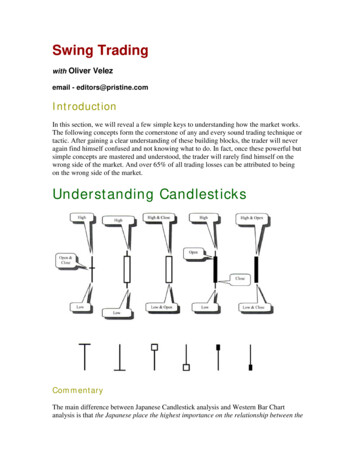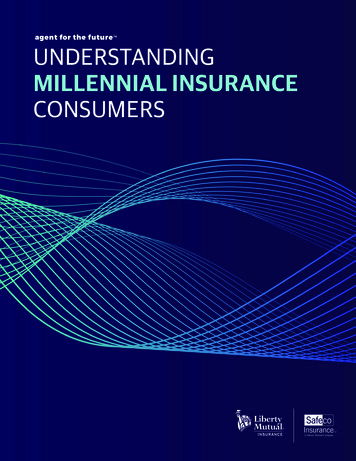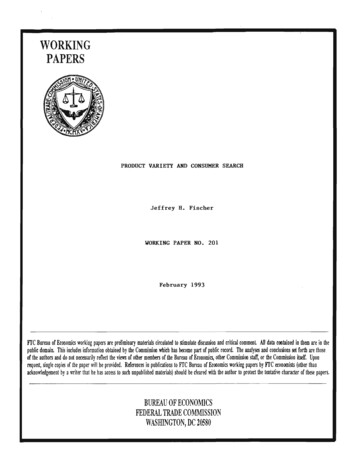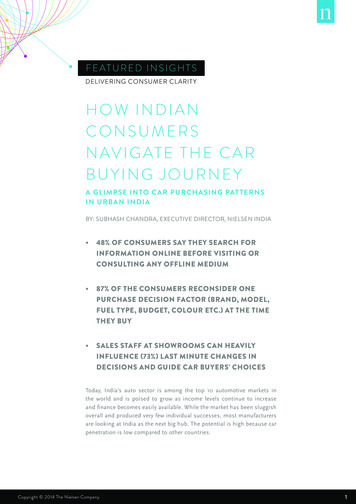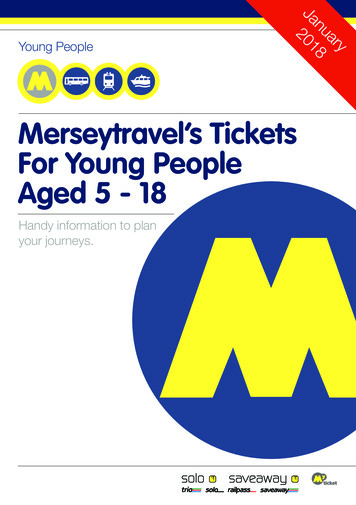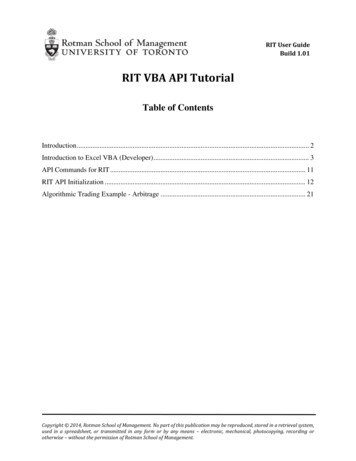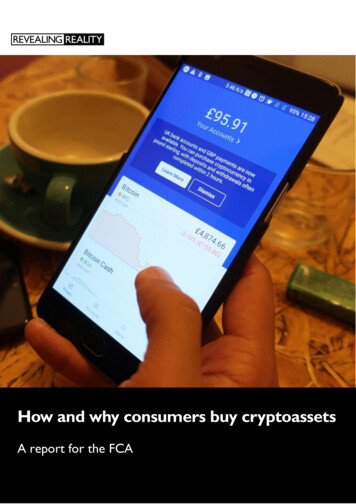
Transcription
HOW AND WHY CONSUMERS BUY CRYPTOASSETSPAGE 1 OF 48How and why consumers buy cryptoassetsA report for the FCA
HOW AND WHY CONSUMERS BUY CRYPTOASSETSPAGE 2 OF 48ContentsContentsWhy was this research needed?GlossaryResearch objectives and method2345About this report6Introduction to the sample7Sampling decisionsReflections on recruitmentMeet the respondents778What prompted people to decide to buy cryptoassets?14Why do consumers decide to purchase cryptoassets?What sources of information influence consumers’ decisions to buy cryptoassets?Understanding of the marketSummary14162326What cryptoassets did people buy and why?27Purchasing platformsDeciding which cryptoassets to buyAssessment of riskSummary27293638Hold or sell?39Selling behavioursTypes of consumer: holding vs sellingWhat next?Summary43454546Conclusions47
HOW AND WHY CONSUMERS BUY CRYPTOASSETSPAGE 3 OF 48Why was this research needed?The rise of cryptoassetsThe story of ‘cryptoassets’ began in 2008 with obscure news coverage of the invention of Bitcoin by themysterious Satoshi Nakamoto1. Initial interest was largely limited to die-hard technologists.As interest began to spread, additional cryptoassets were created. Litecoin2 and Namecoin3 were launched in2011, and from then cryptoassets, particularly Bitcoin, grew in recognition and popularity.At the start of 2017 Bitcoin’s value stood at just under US 1,000, but by the end of the year it was worthnearly US 20,000. The rise of the cryptoassets market was a running news story throughout 2017 and intoearly 2018. Stories about people selling their houses4 or taking on consumer debt5 to buy Bitcoin hit themainstream media.Although the market began to decline6 rapidly in early 2018, many still see potential in its future and continueto buy or hold cryptoassets.Regulation of cryptoassets is complex and evolving. In March 2017, as part of its wider fintech strategy, thegovernment announced the establishment of an FCA, HM Treasury and the Bank of England taskforce oncryptoassets and distributed ledger technology7.Changing information landscapeDespite their relatively recent emergence, the rise of cryptoassets coincides with a period of unprecedentedchange in our digital and media worlds. The dominance of smartphones and social media has changed the waypeople find and consume information, with an associated shift in institutional trust, media literacy andfragmentation of sources8,9,10.The consumer cryptoasset landscapeWhile there has been a great deal of research and debate devoted to the potential uses of cryptoassets,blockchain and the underlying distributed ledger technology, there is a noticeable gap in research that aims tounderstand the experience of purchasing cryptoassets from a consumer perspective.This research explores the attitudes, understanding, motivations and beliefs that underpin people’s decisions tobuy assets in this new and fast-changing landscape and the information and individuals that influence them. Itdescribes what their experiences have been, what their purchases and portfolios look like and considers howthese relate to wider wired.com/2013/08/litecoin/3 oin/4 psite-a7994751.html5 s-risk-taking6 s-more-half-its-value-amid-crypto-crash-n8440567 Final vernment/uploads/system/uploads/attachment data/file/752070/cryptoassets taskforce final report final web.pdf8 https://www.ofcom.org.uk/ data/assets/pdf file/0023/115916/The-Changing-World-of-News.pdf9 https://www.ofcom.org.uk/ data/assets/pdf file/0022/115915/Scrolling-News.pdf10 rust-barometer-2018/12
HOW AND WHY CONSUMERS BUY CRYPTOASSETSPAGE 4 OF 48GlossaryThis report is an independent piece of research and does not include an FCA view on cryptoassets. If you havequestions relating to the FCA’s position on cryptoassets, including the regulatory perimeter, please see theFCA website for more information11. The report contains technical terms and language. Some key definitionsare explained in the boxes below.11What is acryptoasset?There is not a single widely agreed definition of a cryptoasset. As the UKCryptoassets Taskforce notes, cryptoassets are digital representations of valuethat can be transferred, stored or traded electronically which use some type ofdistributed ledger technology.What is theDistribution LedgerTechnology (DLT)?DLT is the technology most cryptoassets rely on. It is a type of technology thatenables the sharing and updating of records in a distributed and decentralisedway. The applications of DLT go beyond cryptoassets as the databases canstore a range of data such as ownership of existing financial assets (e.g. shares),tangible assets (e.g. wine, houses, gold), or digital assets (e.g. Bitcoin).What is an ICO?An ICO, or initial coin offer, is a term used to describe the process when a firmissues a cryptoasset token to support capital raising and/or the creation of adecentralised network. ICOs are also known as ‘token sales’ or ‘coin sales’.Many ICOs will fall outside of regulated space. Whether an ICO falls within theFCA’s regulatory boundaries or not can only be decided case by case. As theFCA has warned previously, sales of tokens through offerings are often veryhigh-risk speculative investments.For definition of cryptoassets nment/uploads/system/uploads/attachment data/file/752070/cryptoassets taskforce final report nary/cryptocurrencyFor definition of Distribution Ledger Technology (DLT) nment/uploads/system/uploads/attachment data/file/752070/cryptoassets taskforce final report final web.pdfFor definition of ICO -coin-offerings
HOW AND WHY CONSUMERS BUY CRYPTOASSETSPAGE 5 OF 48Research objectives and methodThe research objectives were to: Understand the trends and behaviours among consumers currently engaged in the cryptoasset marketlandscapeIdentify and explore different audience types / segments within this landscapeExplore sources of information, touchpoints and influences on these audiences / segmentsEvaluate the potential for risk, harm and vulnerability among consumers with an interest in thecryptoasset landscapeTo meet these objectives, the project set out to investigate a range of consumer experiences of purchasingcryptoassets.The research began with an examination of the media consumers were engaging with that related tocryptoassets, including online media such as news, specialist websites and blogs and social media platforms, forexample Instagram, Reddit, Facebook and Twitter.It then set out to capture participants’ personal stories, exploring the stages in their cryptoasset purchasing‘journeys’ and analysing these in the context of their knowledge, perceptions and expectations of cryptoassetsand their broader experience of investment and financial decision-making.The respondents included a variety of cryptoasset consumers, ranging in age, gender, income and educationlevel. The sample also deliberately included a variety of types of cryptoasset experiences, for example howmany times respondents had invested, the amount they had invested and the value of their current holdings.
HOW AND WHY CONSUMERS BUY CRYPTOASSETSPAGE 6 OF 48About this reportIn exploring consumers’ experiences with cryptoassets, we have mapped decisions and actions at differentmoments in time.The report consists of three chapters:1.The first chapter explores the factors influencing respondents’ decisions to buy cryptoassets inthe first place.2. The second chapter explores respondents’ experiences of purchasing cryptoassets and thecontexts in which these decisions were made.3. The third chapter sets out the actions and consequences for respondents after purchasingcryptoassets.The diagram below indicates these chronological moments in time. At each stage, consumers’ experienceswere influenced by a number of factors, including their general attitudes, beliefs and motivations, theirunderstanding of the cryptoassets market and the sources of information they used.
HOW AND WHY CONSUMERS BUY CRYPTOASSETSPAGE 7 OF 48Introduction to the sampleSampling decisionsThe insight in this report is based on the experiences of 31 consumers of cryptoassets. The sample includedthose who were currently holding cryptoassets, those who had previously held cryptoassets, and those whowere thinking of buying cryptoassets.The study aimed to represent a range of experiences, with a focus on mainstream and potentially vulnerablecustomers. As such, respondents’ purchases in cryptoassets ranged in value, but the majority of them did notexceed 10,000.During the first phase of research, respondents shared the online sources they used to gain information aboutcryptoassets and submitted videos explaining the factors that informed their purchasing decisions. Seventeenrespondents with different degrees of involvement in and knowledge of the cryptoassets market were thenselected for in-depth interviews about their experiences, to capture a range of attitudes, motivations, beliefsand behaviours.Reflections on recruitmentRecruiting respondents for this research was not easy. Those purchasing cryptoassets, or those interested indoing so were often not easily identifiable. In part, this was because purchasing is a largely private activity,taking place behind closed doors. Some people were not comfortable disclosing details about their financialsituation, particularly when they had made losses.Respondents were found through a combination of traditional and investigative recruitment methods.Traditional methods such as using ‘free-find’ recruitment partners were deployed alongside more exploratorystrategies, such as scoping cryptoassets communities on social media and snowballing from existing contacts.Researchers sought participants with different attitudes and beliefs about cryptoassets and included past,current and potential investors. Respondents had a range of experiences with other high-risk financialproducts (e.g. binary options, forex trading, stocks and shares).There was a notably high dropout rate in this research. Some respondents were wary of the method and thein-depth nature of the work, and some did not want to complete the multiple introductory tasks, which theydeemed too time consuming. For many, this was their first experience of market research.A high proportion of the sample was people who did not have, or had actively rejected, structured careers oroccupations. This backdrop is significant, as it provides the context for many of their wider attitudes, beliefsand motivations. As this report will show, many were looking for ways to ‘get rich quick’ and had a propensitytowards pursuing ‘high-risk, high-reward’ strategies for making money.
HOW AND WHY CONSUMERS BUY CRYPTOASSETSPAGE 8 OF 48Meet the respondentsAbdul, 21, small business owner, ManchesterAbdul heard about cryptoassets while he was a student at secondary school in NorthernIreland. During his A-levels, he watched Bitcoin’s price rise. At that time, he decided he was“more interested in writing a business plan” than further study, so he chose not to attenduniversity. At the time of the interview Abdul worked in Manchester running a businessorganising music events, and as a freelance graphic designer.Abdul first purchased and traded Bitcoin, Ethereum and Litecoin in November 2017 “to getan understanding of things”. He relied on one “expert” friend for all his cryptoassetpurchases and trading decisions. For example, after a tip from this friend, he purchased “apre-market buy-in coin” Pareto PXT at 250, which he said had increased to 2,250. He soldsome of this and used the rest to purchase the initial coin offering (ICO) indaHash. Abdulhopes to build his own understanding and ability to read price graphs, so he does not have torely on his friend and can continue to supplement his income making profits on cryptoassets.Kyle, 22, student, ManchesterKyle lives in Manchester where he is studying modern history with economics at university.Kyle “partied hard for a few years” but now runs the volleyball team and has stoppedsmoking cannabis, which has allowed him to have enough money to purchase cryptoassets.Before studying, Kyle worked as a broker in binary options. After graduating he hopes towork in either recruitment or sales.Kyle dealt with cryptoassets when he was 16 to purchase illegal drugs online, but it was“only when I was 20 or 21 when I saw it as an investment”. Kyle bought 1,100 worth ofBitcoin, Ripple, Tron, Excelen, Appcoin and Elastos with his student loan in January 2018.His purchase was made “at the worst possible time” by his own admission, as the value ofBitcoin plummeted just a few weeks later.Neil, 24, part-time personal trainer, LeedsNeil is a personal trainer who works part time. After dropping out of university due toconcerns about his student debt, he now lives at home with his mum and sister. He works asan Uber Eats driver to supplement his income and is hoping to grow his personal trainingclientele in the next six months. In his spare time, he likes to take up new hobbies such ascooking or different fitness classes.Neil first heard about cryptoassets and Bitcoin when he read an article about the dark web.In March 2017 he bought 2,000 worth of Bitcoin with all his savings. In 2018 he took somemoney out of Bitcoin and spread it into a bundle of eight ICOs. When he was interviewed hewas waiting for his holdings to grow – at the time they reportedly stood at 500.
HOW AND WHY CONSUMERS BUY CRYPTOASSETSPAGE 9 OF 48Luke, 26, partner in a group of independent stores, BirminghamLuke lives in Birmingham with his girlfriend and young children and is a partner in anindependent tattoo studios business. He also runs an online clothes company. Luke hadpreviously invested in Forex, losing 200, which he said he was comfortable with because hewas learning to trade and anticipated the risk.Luke is aware that he does not know much about cryptoassets but wanted to be involved“before it gets mainstream”. He says he is always trying out new things and new investmentsand has received much of his advice from two online influencers, one of which he considers a“mentor”. Luke purchased 1,200 in cryptoassets, which at the time of the interview hevalued at 1,620. He is currently holding Bitcoin and Litecoin and previously also purchasedEthereum.Angela, 26, HR in luxury fashion, LondonAngela lives with her boyfriend in a house they own together in London. She works in HRfor a luxury fashion company and hopes to be promoted to a senior HR role.Angela had read about the rapid rise in value of cryptoassets in newspapers and magazinessuch as Business Insider, the New York Times and the Independent. She has several friendswho work in ‘financial services’, who would talk about investments in cryptoassets andstories of others making gains – something that “made it seem much more legitimate”. Forher, the catalyst for investing was when her company hired a new temporary director whohad purchased cryptoassets, who shared his view that Litecoin was the next cryptoasset toincrease in price.Angela purchased two Litecoins at 650, deciding not to consult her boyfriend or peers whoknew more about the market: “I wanted to feel like I did it on my own.” She felt that Bitcoinwas a “safer investment” but couldn’t afford to buy a “whole one”, so instead preferred tobuy two whole Litecoins. Her purchase fell quickly, and at the time of the interview wasworth 86 in total. Angela regrets her decision to buy cryptoassets: “I only did my researchafter I had already bought them, which is when I started reading about how a lot of peoplecreated ‘hype’ around particular cryptocurrencies.”Ashton, 26, musician in a wedding band, small village in the MidlandsAshton has recently moved out of his parents’ house to his own rented house and is workingas a musician in a wedding band. He reports that another ‘job’ is daily spread betting fromwhich he makes around 500 per month.Ashton started purchasing cryptoassets in March 2017. He had heard about Bitcoin and wasintrigued by stories of people becoming multimillionaires. However, he thought he hadmissed his chance and was instead investing in the S&P 500 Index. He then moved all hissavings ( 13,000) to Ethereum after he saw some comments on Investopedia. After sixmonths of poor results with Ethereum he moved all his value to XRP (Ripple), as he thoughthe could get better returns. In December Ripple’s value increased sharply and Ashton saidhis purchase was worth 150,000. “I got addicted to making money while I slept.” However,he didn’t sell until he had lost 90% of his portfolio value. In April 2018 he decided to diversifyhis portfolio and acquired another six types of cryptoasset. He believes that it will “pullthrough” one day, and that he will be able to retire early as a millionaire in the next fewyears.
HOW AND WHY CONSUMERS BUY CRYPTOASSETSPAGE 10 OF 48Fred, 26, social media content creator for a tabloid newspaper, LondonFred lives in London in a shared flat and is working as a video content creator for a tabloidnewspaper. He received some inheritance money a couple of years ago, which is in a currentaccount and he is not sure what to do with it. He has been researching hedge funds onGoogle to work out how to invest his money.Fred first heard about cryptoassets from his brother who had purchased some. However, hisdecision to purchase some came after talking to a taxi driver, who said he had put himselfthrough college with profits from “investing” in cryptoassets. Fred purchased 300 spreadacross Bitcoin, Ethereum and Litecoin, which he said at the time of the interview was nowworth 95. Fred regrets his decision to purchase cryptoassets, and believes it was a bad idea:“Looking back I am ashamed of my investment and losing money.”Rick, 26, part-time work at his family’s small company, HastingsRick dropped out of university after two years because he felt “it was a waste of time”. Sincethen he has worked in insurance and real estate, and now works part-time at his family’scompany, which imports and distributes electric parts. He is also doing an online businesscourse and says his future looks “dire, but education is the light at the end of the tunnel”. Helives with his parents.Rick became interested in cryptoassets because they were “the word around town” – hisfriends were talking about how they could be a way to make a lot of money. In early 2017 hebought 350 of Ethereum and Litecoin and later traded it all for Cardano and Tron. In late2017 he valued his cryptoassets at 1,500 but he did not cash out because he thought theywould grow even more. Rick reported that his portfolio’s value fell to 500, when hedecided to keep his cryptoassets and wait for them to regain value in the future. Rick alsoconvinced his parents and girlfriend to buy Cardano – which he felt to be the “safer option”.Damien, 32, French and English tutor, BrightonDamien lives in Brighton with his wife and two young daughters. They plan to become debtfree in the next year and apply for a mortgage. Damien also hopes to run his own postgraduate course.Damien became involved in cryptoassets after being invited by a friend to an event run by‘Omnia’, a multi-level selling and trading system for cryptoassets. He then joined the TradingCoin Club, through which he bought and traded ‘TCoin’. He initially purchased 700 worthof TCoin, which at the time of interview was valued at 500. Damien has decided to makefurther cryptoasset purchases and is “looking into buying a bundle”, as he believes that “withcryptos it’s now or never”.Elena, 34, former marketing director for an ICO in Bulgaria, LondonElena moved to England from Bulgaria last year to pursue a career as a writer. She is“comfortable financially” from her previous work in marketing and she works part-time in anadmin role at a local orthodontist surgery.Elena has a relatively long history with cryptoassets as she previously worked as a marketingdirector for one of her friend’s ICOs. Elena knows how external influences can drive marketmovements, therefore affecting cryptoassets’ value. Elena has purchased many cryptoassetsand recently bought Polkadot with 60,000, reporting a profit of 40,000. She valued her
HOW AND WHY CONSUMERS BUY CRYPTOASSETSPAGE 11 OF 48current cryptoasset holdings at 200,000 at the time of the interview. Her main influence isa friend whom she describes as a ‘genius’, and whom she believes is well connected to an‘inner ring’ of cryptoassets influencers - such as founders of ICOs.Justin, 40, freelance graphic designer, HertfordshireJustin is an artist and concept designer for film and TV. He switched careers 10 years agofrom working in a bank. He loves his job, particularly as he’s not tied to a desk and canexplore his passions for film, gaming and new developments in these fields. He likes to keepup with the news and follows a number of international channels. Prompted by his boss atthe time, he invested in Orange shares in 2001 “without much research” and sold out fiveyears later.Justin is convinced that cryptoassets will be the currency of the future. He compared themwith the internet, saying that it too was only for experts at first, but has since exploded andis now a key part of people’s lives. He purchased 2,000 of various cryptoassets in severalconsecutive instalments using “money I could afford to lose”. He valued his portfolio at thetime of interview at just under 1,500. Justin gets his news mostly from specialised onlinemagazines such as Coindesk, Coin Market Cap and AMB Crypto.Sandy, 43, part-time book designer, LondonSandy lives in London with her partner and two sons. She works part-time as a bookdesigner and home-maker. She learned about “financial investments” from her step-fatherand brother, who are “businessmen and love money,” and had experience of buying stocks in2016.Sandy was first exposed to the cryptoassets world through mainstream newspapers such asthe Guardian and the Independent. She purchased 2,000 of Bitcoin, Ethereum and Litecoin,and at the time of the interview she said she had 800 in her holdings. Sandy says she“doesn’t care about the profit”, but rather is a big believer in “cryptoassets having a brightfuture”. She wants to have her “foot in the door” because of the promise she sees in thetechnology.Maria, 57, care home cleaner and cook, LondonMaria used to work as an accountant in Portugal. She invested all her savings in a restaurantthere in 2008 which went bankrupt. In 2014 she moved to London seeking a well-paid job,and since then has been working as a cleaning lady and cook in the care home where shelives.Maria first heard about cryptoassets on Portuguese news channels in January 2017, which shesays suggested that buying them would be “the best investment you will ever make”. Mariabought 100 worth of Ethereum because Bitcoin was too expensive, and she couldn’t “buy awhole coin”. Initially when she was making money she “was really excited and checked itonce or twice a day. But after it started to fall I stopped looking, now I only check it once amonth”. She said at the time of interview that the value of her purchase dropped to 17.However, Maria recently bought 5 in Ripple after seeing adverts on the Facebook page ofan e-money provider she subscribes to and has an account with. She hopes cryptoassets willpick up again and make her a lot of money in the future.
HOW AND WHY CONSUMERS BUY CRYPTOASSETSPAGE 12 OF 48Karina, 31, police officer, LondonKarina lives on her own and works as a police officer on a knife crime team. In her sparetime, she is completing a degree in English language. She holds shares at the value of 500 inLloyds and TSB, which she received from her mum.Karina first came across cryptoassets after reading a tweet by a music artist who wasallowing purchases of his album with Bitcoin. Later she was influenced by the mainstreammedia to purchase Ethereum, Bitcoin and Litecoin at 1,500 in August 2017 – she felt thatthe media’s message was “get on the boat now or you won’t be getting on it at all”. Shereported that her purchase increased by 700, at which point she sold her initial cryptoasset purchase and has kept the increase. Karina was influenced to divest her initial purchaseby the media when she found they no longer predicted price increases in Bitcoin but focusedon when it would crash. She considers herself lucky not to have lost money, but now wantsto watch the market from afar and is not planning any future purchases of cryptoassets.Eric, 29, unemployed recent microbiology MPhil graduate, AberdeenEric recently graduated with an MPhil in microbiology and has been looking for a job sinceMay. He and his wife have lived in Aberdeen for 10 years. Eric is extremely well informedabout technology: he has been learning about computer software since he was nine yearsold, and coding is one of the hobbies he is passionate about – as well as offline and onlinevideo games.He started by purchasing 1,500 worth of assets in Ethereum, Ripple, Cardano and Tron inSeptember 2017 to “assess their development”. A month later he exchanged it all for Tronand Cardano. He suggested that Tron was a “good short-term investment” because it had a“great PR strategy” and hence a “profitable hype around it”. He concluded that Cardano wasinstead a good “long-term investment” because of the technology it supported. Six monthsafter his first purchase Eric cashed out 11,000, which contributes to his living expenses.Jake, 46, financial manager, YorkJake lives near York with his wife, after his two adult children left the family home. He isinterested in financial products in general and has invested in both shares and gold in thepast. He wants to “build a financial future” for him and his wife, as they have faced some bigmedical expenses lately and he’s concerned about his pension.Jake became interested in cryptoassets because the financial publications and newsletters hefollows (e.g. Creating Wealth and The Palm Beach Daily) started featuring blockchain. Hesees cryptoassets as a “short term investment”, as he thinks that “the market is still in itsinfancy” and therefore unpredictable. He only trusts Bitcoin, as he thinks the othercryptoassets will simply follow the same trends, and he’s suspicious about the number ofnew tokens appearing. He purchased Bitcoin six times in the past 18 months ( 500/ 1,000 attime), reportedly selling each time after making a 200% profit. He cashed out when he sawmarket trends declining. While he doesn’t rule out buying again, he said he would do sowhen he sees the start of a new positive trend.
HOW AND WHY CONSUMERS BUY CRYPTOASSETSPAGE 13 OF 48Nick, 18, college student working part-time in a phone store, EssexNick is a college student living with his parents and working part-time. He is studyingbusiness and wants to get an apprenticeship in London. He saved money for two years whichhe recently used to buy a car, of which he is very proud. He describes his iPad, iPhone andcar as his “assets.”Nick is heavily influenced by ‘celebrity’ investors he follows on social media, who post aboutmaking lots of money by investing in cryptoassets. Nick believes: “If you are brave enough torisk the gamble then you can make lots of money, but you are more likely to lose money.”Nick came across cryptoassets for the first time when he was 10 years old. He neededBitcoin to buy a “football team for my FIFA videogame”. Currently he wants to buycryptoassets but has spent his money on his car, so is waiting until he is able to save upenough again.
HOW AND WHY CONSUMERS BUY CRYPTOASSETSPAGE 14 OF 48What prompted people to decideto buy cryptoassets?Respondents’ decisions to buy cryptoassets were influenced by a range of factors. These included theirattitudes towards making money in general; the information they received and sought out; and their beliefsabout and understanding of the cryptoassets market.This chapter will explore these factors, which often set the stage for consumers’ subsequent experiences.Why do consumers decide to purchase cryptoassets?Getting rich quickMost respondents expressed a desire to make significant amounts of money in their lives, and while somewere looking for ways to supplement their income, others had explored a variety of ways to try to ‘get richquick’ without having to work.This desire to become wealthy with minimal effort seemed to attract them to the world of cryptoassets, andmany expected the cryptoassets they bought – in contrastto other investment options – to increase in value steeply over a short period of time.Particularly for the younger people in the sample, this seemed to be related to a more general aversion totraditional forms of employment and an attraction to lifestyles of leisure and making ‘easy money’ with littleeffort. For example, Kyle spoke about his experience of being one of the ‘poorer’ children in a wealthy privateschool, which meant his friends’ parents had large houses and expensive items. Kyle hoped to achieve this sortof wealth in his adult life, and felt that cryptoassets were a good way to get ahead.Similarly, Ashton had no intention of taking up the career in real estate he said his parents wanted for him, norhad he taken steps to pursue an alternative career path. Before he bought cryptoassets, he had been involvedin spread betting, forex trading and investing in the S&
products (e.g. binary options, forex trading, stocks and shares). There was a notably high dropout rate in this research. Some respondents were wary of the method and the in-depth nature of the work, and some did not want to complete the multiple introductory tasks, which they deemed too time consuming.
